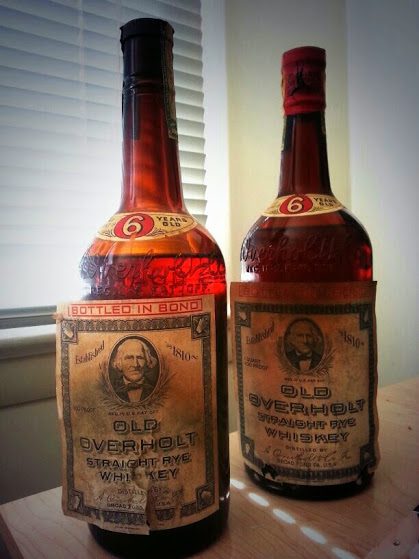 |
| Branded as Gibson's Distilling Co. - this bottle actually contains whiskey from Stewart Distillery, Baltimore. Made prior to September, 1917. |
 |
| Stewart Distillery, RD No.12, Baltimore, MD around 1909 |
I Prohibition era bottling of Maryland Rye - labeled "Gibson" but actually "Stewart"
 Distilled prior to September 8th, 1917 at The Stewart Distillery. Two stories in one because the bottle is labeled one way, but contains a different whiskey. This kind of thing was common in Prohibition when brands were consolidated into a few companies who had medicinal whiskey licenses to sell to pharmacies. Actual whiskey was taken from closed distilleries and stored together in a smaller number of more defensible concentration warehouses and brands and spirits were often conflated as expediency demanded. In this case we have Lewis Rosensteil's Schenley operation - which would become the second largest liquor company in the United States (second only to American Medicinal Sprits, which became National Distillers after Repeal). Rosensteil's concentration warehouse was at Schenley PA, RD No. 2 - and sure enough - the back label on this bottle says that whiskey from Stewart Distillery, Baltimore was "bottled for" Gibson Distilling Co. of Brownsville, PA (the heart of the Monongahela region), at Schenley's concentration warehouse.
Distilled prior to September 8th, 1917 at The Stewart Distillery. Two stories in one because the bottle is labeled one way, but contains a different whiskey. This kind of thing was common in Prohibition when brands were consolidated into a few companies who had medicinal whiskey licenses to sell to pharmacies. Actual whiskey was taken from closed distilleries and stored together in a smaller number of more defensible concentration warehouses and brands and spirits were often conflated as expediency demanded. In this case we have Lewis Rosensteil's Schenley operation - which would become the second largest liquor company in the United States (second only to American Medicinal Sprits, which became National Distillers after Repeal). Rosensteil's concentration warehouse was at Schenley PA, RD No. 2 - and sure enough - the back label on this bottle says that whiskey from Stewart Distillery, Baltimore was "bottled for" Gibson Distilling Co. of Brownsville, PA (the heart of the Monongahela region), at Schenley's concentration warehouse.These are interesting brands. Gibson's was a classic pre-Prohibition high-rye mash bill "red" Mongahela valley rye. Rosensteil purchased the brand and had obviously run out of the juice by the time this bottle was filled. Schenley shifted production of Gibson's up to Canada after Repeal, and Gibson's remains one of the major brands of Canadian whisky to this day. It's fascinating to see that its roots are in PA rye.
Stewart's is one of the brands of Maryland rye that disappeared with Prohibition. In a 1920s lawsuit, the plaintiff alleged that the Stewart's Rye Whiskey brand dates back to 1788 (it also appears as Robert Stewart Distillery in the late 19th century). According to tax records it was self-owned until 1901 when it was sold to the Carstair's Brothers - best known for Carstair's White Seal (another venerable Baltimore rye brand with 18th century roots. Carstair's White Seal became a blended American whiskey after WWII).
This particular bottle has a front label that is age stated as 11 years old. On the back is that odd statement "Made prior to September 8th, 1917". The bottled in bond tax strip is missing so we can infer that this is probably a 1917-1928, or possible a 1916-1927 (or a 1915-1926).
So this medicinal pint represents a rare opportunity to taste the whiskey from a vanished and historic Baltimore MD distillery which was part of the formation of Lewis Rosensteil's Schenley Industries in its heady formative days.

II 1955-1961 Jim Beam Bonded In Bond blue glass "Grecian" decanter. 100 proof.
How did mid-century Jim Beam differ from today's expressions? Find out. This lovely piece of mid-century kitch is a Mad Men era classic. The decanter is blue glass - so there's no lead risk. It feels and sounds full. This bourbon is should be a rich with that mid-century heavy vanilla and brown-sugar loaded sweetness and that characteristic Jim Beam "funk" (which some people tastes like a barn smells - and other people say is "earthy").
This is a classic case of a historic American distillery which is still in major production. Continuity and tradition will stand against industry changes in types of corn, length of mashing period, rising barreling proofs, shorter maturation periods, and other "enhancements to production". Bottle maturation might also be a factor. It's a half-century plus old decanter - who knows? That's part of the fun of cracking a dusty.
And that's not all! Josh Richholt is bringing some classic dusty Bourbons for our enjoyment as well:
a 1978 Wild Turkey 8/101 and a 1976 Bourbon deLuxe from National Distillers. These are legendary delicious classics.
Want to attend. Get your tickets here:
https://www.eventbrite.com/e/beast-masters-club-dusty-battle-tickets-38289228112
 |
| The green bottled in bond tax strip on the Beam Grecian Decanter showing the year and season of distillation - and of bottling as a 6 year old. |








